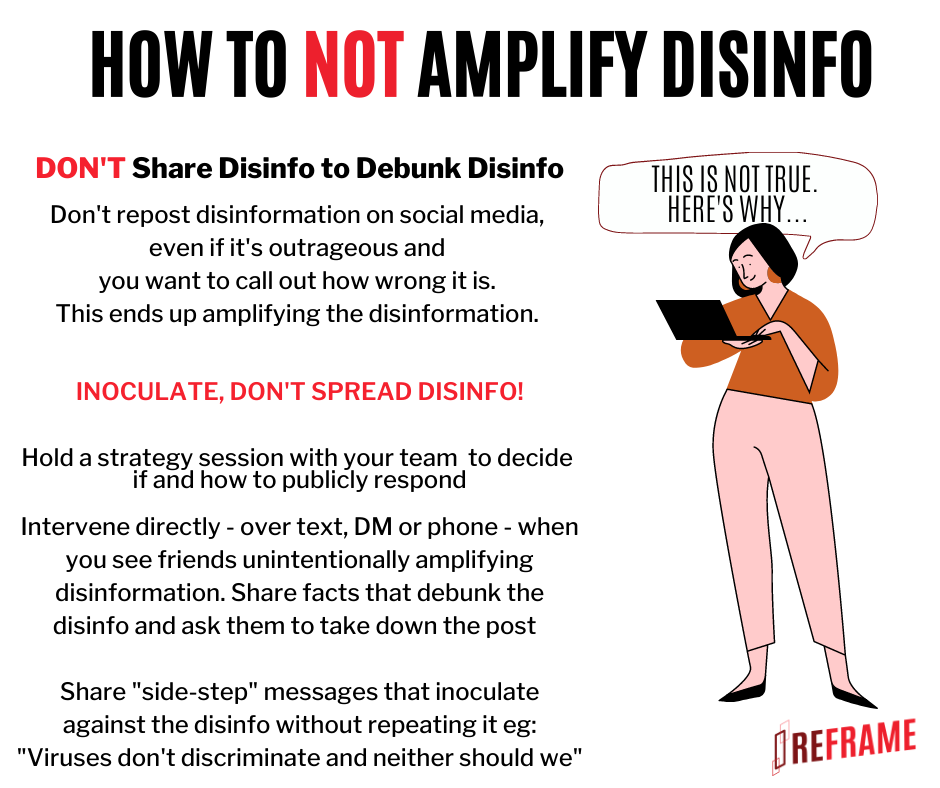
We have heard a lot about disinformation during this past year, but learning more about how information is manipulated, distorted and deployed to shape social debates can help you recognize when you are being targeted in a disinformation campaign. It can also help you understand the disproportionate impact this problem has on communities of color and social justice movements.
First, let’s review the terms. Misinformation is the most general term. It refers to false or inaccurate information that is communicated regardless of an intention to deceive. Disinformation refers to a qualitatively different phenomenon, that of deliberately and often covertly spreading false information to sway opinion or distract the audience. Misinformation might include incidents of simply getting the facts wrong (e.g., claiming Peoria is the capital of Illinois), while disinformation is willfully spreading rumors to gain an advantage.
A less common term you might see is malinformation, referring to the use of information which may be based on reality, but is used to inflict damage. Revealing irrelevant personal details of an opponent to the public, taking historic events out of context or providing incomplete accounts of an action are good examples of malinformation.
Racialized disinformation is the most complex but also the most important term here. It describes disinformation campaigns that specifically target communities of color. These campaigns use strategies that may include the impersonation of people of color online or disinformation that is designed to disproportionately impact communities of color. Recently these techniques have been employed to suppress or motivate voter blocks, to disparage communities through false rumors about COVID and to spread fear through false reports of ICE raids or criminal attacks.
The Impact of Disinformation Goes Beyond Elections
Disinformation is discussed frequently in regard to elections, but the harm it poses to social justice movements is rarely addressed. International interventions in our information systems (such as the impact of Russian-origin Facebook groups targeting voters) spur concern, but domestic disinformation campaigns often escape scrutiny. Sadly, domestic disinformation campaigns, aided by the negligence of social media platforms, significantly weaken community movements.
Due to the heightened political activity of Black and brown people, these communities are targeted with wedge-issue disinformation campaigns intended to undermine intra- and intercommunity solidarity and generally erode trust in information. These campaigns have disproportionate access to communities of color because of the reliance of these groups on messaging apps as tools of communication and information access. And as communities of color continue the fight for liberation, opponents will continue to erode these communities’ access to information and promote inaccurate narratives to derail movements.
2020 has been a year of tremendous growth in awareness of the need to combat disinformation. First, the integrity of the elections was threatened by efforts to negatively influence voter turnout and choices, and to undermine overall confidence in democratic institutions. Second, the global COVID-19 pandemic illustrated the importance of assuring that all communities had access to reliable medical information and also illustrated the way disinformation could exacerbate the medical crisis. Finally, the impact of disinformation, malinformation and misrepresentation on the progress of freedom movements was made starkly evident in the months after George Floyd’s murder.
Building a Network to Counter Racialized Disinformation
MediaJustice (formerly the Center for Media Justice), was formed in 2009 to focus on countering homegrown racialized disinformation campaigns emboldened by the rise of fascism in the US. MediaJustice focuses on addressing racial, gender and economic inequities by building media literacy, addressing problems of media representation and protecting the digital rights of communities of color. It encourages these communities to demand the removal of regulatory barriers that hinder robust and reliable access to “minority”-owned media. It demands that social media platforms value access to accurate and reliable information over their profits and take responsibility for banning and removing blatant disinformation campaigns and the networks that foster them.
MediaJustice works with network partners to provide opportunities to learn about how disinformation functions, as well as how to intervene and disrupt it. In October, MediaJustice organized a national week of action, designed specifically to train and educate organizers, advocates and grassroots activists on how to combat disinformation in their communities. MediaJustice worked to spread the lessons through community partners, including the Champaign-Urbana Independent Media Center.
Not just a Twenty-first Century Topic
While the fight against disinformation, misinformation and malinformation has become a mainstream issue with the rise of Donald Trump, communities of color have been suffering disinformation campaigns for decades. Government conspiracies such as COINTELPRO (the FBI’s Counter Intelligence Program), the Tuskegee Syphilis Study and widespread voter suppression disinformation campaigns eroded the tenuous trust communities of color had in institutions, leaving them vulnerable to the spread of well-intentioned misinformation.
Media consolidation has played a strong role in the deterioration of trust in information as well. Historically, Black newspapers and radio stations acted as community pillars in sharing reliable information and dispelling disinformation. While the expansion of the internet has opened new opportunities for Black and brown media and improved general access to information, it has not acted as a corrective to disinformation, as did earlier Black institutional media. Instead, the internet, with the aid of algorithm-driven platforms like Facebook, Twitter and YouTube, has often served as a tool to amplify inaccurate or harmful information.
But Facebook and YouTube remain the most widely used social media platforms by American adults, with Black and brown communities overrepresented in their use of these sites. They have used these platforms to bypass white institutional media gatekeepers, correct harmful narratives, generate additional income and expand organizing potential for movements. WhatsApp, hosting nearly 70 million users in the US, remains a highly popular messaging tool among communities of color, particularly immigrants who use these apps to communicate with family members abroad.
General Guidance on Responding to Disinformation
Recognizing disinformation is one thing, knowing what response to take is another. The principles below can help navigate the challenge of disinformation.
First, avoid amplification by not engaging with disinformation. Do not like, comment or share―even to debunk—because that tells the algorithms that the message is important. Social media algorithms feed on engagement, whether negative or positive, and reacting with “angry” to a post still boosts it and leads more people to see the disinformation.
Second, report it. If you encounter a piece of disinformation, flag it for removal from the social network or submit it to the tip line for further evaluation.
Finally, avoid cross-pollination. If you see an inaccurate post on Facebook, avoid posting on Twitter about it, even to remark that it is incorrect. That only helps the disinformation to spread on other platforms.
If you think you must engage with disinformation that has high-stakes consequences, follow the following model. First, prime people to be skeptical readers by pointing out (using non-controversial examples) how easy it can be for anyone to unintentionally spread false information. Second, rather than attack or insult the poster, acknowledge shared concerns, then pivot to a proactive, positive message. Finally, redirect the reader to accurate information.
A Media Strategy for a Just Society
Disinformation is not a victimless crime. It weakens communities by sowing divisions and distrust, and unfairly targets communities of color and social justice movements. Confronting this threat requires building new, trusted networks of information. In general, local community leaders are the most effective drivers of messages of action and transformation. A commitment to media justice means uplifting leaders who represent underrepresented voices, and includes varied messengers (e.g., business owners, faith leaders, etc.). Finding those voices and making sure they have the access to reliable information and reliable platforms from which to deliver effective messages is the best strategy for protecting communities against the injustice of disinformation campaigns.

Kiana Kazemi is a Disinformation Defense Campaign at the UCIMC and a recent graduate of The Fletcher School at Tufts University, where she studied International Relations.
